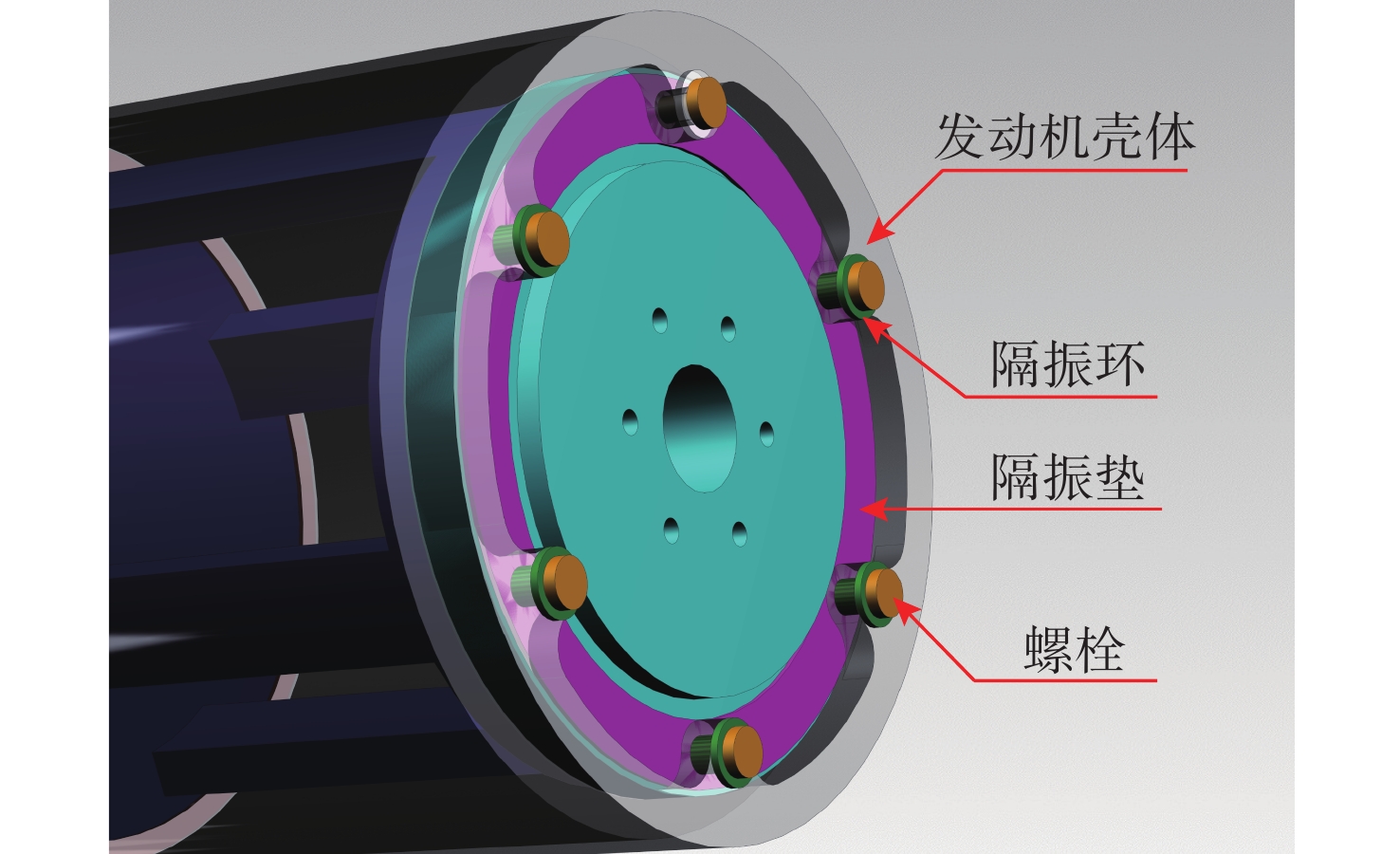Application of Bolt Vibration Isolation Structure in Torpedo Noise Control
-
摘要: 为进一步研究隔振结构在鱼雷噪声控制中的作用, 文中通过建立基于梁模型的隔振材料动力特性识别实验台, 对聚醚醚酮材料的弹性模量和阻尼进行了识别和验证。同时建立了螺栓隔振结构的有限元模型, 并验证了模型的精确性。将该模型应用于鱼雷发动机与壳体连接处, 首次结合隔振圈建模理论和螺栓隔振结构, 建立了鱼雷动力的整机隔振仿真模型。仿真结果揭示, 综合使用隔振圈结合螺栓连接的隔振措施可使鱼雷振动噪声降低3.64 dB。研究结果为鱼雷振动噪声控制提供了有力的理论支撑。Abstract: To further investigate the role of vibration isolation structure in torpedo noise control, in this paper, a dynamic characteristic identification bench of vibration isolation materials based on a beam model was established, and the elastic modulus and damping of poly-ether-ether-ketone materials were identified and verified. The finite element model of bolt vibration isolation structure was established, and the accuracy of the model was verified. The model was applied to the connection between the torpedo engine and the shell. Combined with the vibration isolation ring modeling theory and bolt vibration isolation structure, a torpedo-powered vibration isolation simulation model was established for the first time. The simulation results show that the vibration noise of torpedoes can be reduced by 3.64 dB by comprehensively using vibration isolation rings combined with bolt connections. The results provide strong theoretical support for torpedo vibration noise control.
-
表 1 弹性模量求解结果
Table 1. Elastic modulus results
单位:Pa 编号 1 2 3 4 5 平均值 PEEK1 1.008×1010 1.011×1010 1.011×1010 1.011×1010 1.012×1010 1.01×1010 PEEK2 8.082×109 8.169×109 8.224×109 8.271×109 8.265×109 8.20×109 PEEK3 9.906×109 1.018×1010 1.016×1010 1.024×1010 1.023×1010 1.01×1010 PEEK4 9.487×109 9.517×109 1.104×1010 9.310×109 9.313×109 9.73×109 PEEK5 9.428×109 9.405×109 9.390×109 9.508×109 9.473×109 9.44×109 PEEK6 1.083×1010 1.121×1010 1.105×1010 1.104×1010 1.098×1010 1.10×1010 PEEK7 1.531×1010 1.532×1010 1.529×1010 1.534×1010 1.536×1010 1.53×1010 PEEK8 8.573×109 8.678×109 8.649×109 8.648×109 8.721×109 8.65×109 PEEK9 8.174×109 8.122×109 8.032×109 8.043×109 8.066×109 8.09×109 PEEK10 8.300×109 8.409×109 8.411×109 8.419×109 8.458×109 8.40×109 表 2 等应力梁弹性模量实验结果
Table 2. Test results of elastic modulus with equal stress beam
位置 实验1 实验2 弹性模量/Pa 误差% 弹性模量/Pa 误差/% 位置1 8.81×109 1.84 8.74×109 1.04 位置2 9.36×109 8.20 9.19×109 6.24 表 3 阻尼比结果
Table 3. Damping ratio results
编号 ω/Hz ξ PEEK1 30.042 0.007 PEEK2 31.956 0.008 PEEK3 31.416 0.008 PEEK4 31.523 0.009 PEEK5 32.089 0.005 PEEK6 33.104 0.006 PEEK7 37.095 0.010 PEEK8 28.473 0.005 PEEK9 27.672 0.005 PEEK10 29.875 0.010 表 4 不同阶次下固有频率
Table 4. Natural frequencies at different orders
阶数 固有频率/Hz 橡胶 PEEK 1 100.95 39.76 2 158.01 109.40 3 362.27 207.92 4 468.67 334.36 5 758.04 491.72 表 5 鱼雷组件材料参数
Table 5. Material parameters of torpedo components
组件 材料 密度/(g·cm3) 弹性模量/MPa 泊松比 $\alpha $ $\beta $ 隔振圈 丁腈橡胶 1.10 5.00 0.40 1.40×10−5 19.84 金属橡胶 2.30 7.84 0.30 2.06×10−4 297.63 隔振垫
隔振环PEEK 1.40 8.40×103 0.38 1.30×10−5
1.50×10−44.19
50.33壳体、隔板等 结构钢 7.85 2.00×105 0.30 — — 表 6 典型节点振动烈度和振动噪声
Table 6. The calculation results of vibration intensity and vibration noise of some nodes
节点编号 振动烈度/(mm/s) 振动噪声/dB 降噪效果/dB 低阻尼材料 高阻尼材料 低阻尼材料 高阻尼材料 108 1.939 342 1.277 884 105.557 4 101.928 7 3.628 637 120 1.995 689 1.332 296 105.782 8 102.248 8 3.533 955 207 1.967 842 1.312 443 105.671 4 102.132 0 3.539 351 640 1.941 273 1.331 294 105.565 1 102.242 9 3.322 186 725 1.945 700 1.353 521 105.582 8 102.373 7 3.209 151 -
[1] 曹浩, 张伟伟, 文立华, 等. 鱼雷动力系统振动控制技术及应用研究[J]. 水下无人系统学报, 2019, 27(5): 595-600.CAO H, ZHANG W W, WEN L H, et al. Research on vibration control technologies of torpedo power system and its application[J]. Journal of Unmanned Undersea Systems, 2019, 27(5): 595-600. [2] 段勇, 刘瑞杰, 马琳. 金属橡胶在鱼雷推进轴系振动控制中的应用[J]. 船舶力学, 2020, 24(9): 1187-1195. doi: 10.3969/j.issn.1007-7294.2020.09.011DUAN Y, LIU R J, MA L. Application of metal rubber to the vibration control of torpedo propulsion shafting[J]. Journal of Ship Mechanics, 2020, 24(9): 1187-1195. doi: 10.3969/j.issn.1007-7294.2020.09.011 [3] 辜长庆. 鱼雷辐射噪声控制[J]. 舰船科学技术, 1992(3): 22-26. [4] 肖汉林, 于俊卫, 张瑞斌, 等. 鱼雷电机-艉轴系统振动与声辐射特性分析[J]. 鱼雷技术, 2005, 13(4): 33-36.XIAO H L, YU J W, ZHANG R B, et al. Research on vibration and acoustic radiation characteristic of torpedo electric motor and stern shaft system[J]. Torpedo Technology, 2005, 13(4): 33-36. [5] 高爱军. 基于四端参数分析法的鱼雷动力隔振技术研究[J]. 鱼雷技术, 2007, 15(1): 29-32.GAO A J. Research on vibration isolation for torpedo power based on four-end parameter analysis method[J]. Torpedo Technology, 2007, 15(1): 29-32. [6] 金晶, 张振山, 熊鑫. 一种橡胶隔振圈动刚度计算方法[J]. 鱼雷技术, 2012, 20(2): 125-128.JIN J, ZHANG Z S, XIONG X. Dynamic stiffness calculation method for rubber ring isolator[J]. Torpedo Technology, 2012, 20(2): 125-128. [7] 王敏庆, 胡卫强, 盛美萍. 阻尼处理在鱼雷振动噪声控制中的应用[J]. 弹箭与制导学报, 2005(4): 779-780, 783. doi: 10.3969/j.issn.1673-9728.2005.04.253WANG M Q, HU W Q, SHENG M P. Damping and its application in vibration and noise control of torpedo[J]. Journal of Projectiles, Rockets, Missiles and Guidance, 2005(4): 779-780, 783. doi: 10.3969/j.issn.1673-9728.2005.04.253 [8] 梁跃, 何长富, 彭博. 鱼雷热动力发动机机体振动模态分析[J]. 鱼雷技术, 2005, 13(4): 17-20.LIANG Y, HE C F, PENG B. Structural vibration modal analysis of torpedo thermal power engine[J]. Torpedo Technology, 2005, 13(4): 17-20. [9] 张可. 聚醚醚酮及其纳米复合材料的力学性能[D]. 大连: 大连理工大学, 2021 [10] RAE P J, BROWN E N, ORLER E B. The mechanical properties of poly(ether-ether-ketone) (PEEK) with emphasis on the large compressive strain response[J]. Polymer, 2006, 48(2): 598-615. [11] KURTZ S M. PEEK biomaterials handbook[M]. New York, USA: William Andrew, 2014. [12] 王飞, 王衔, 陈涛, 等. 瑞利阻尼在Abaqus中的实现[J]. 计算机辅助工程, 2018, 27(5): 72-76.WANG F, WANG X, CHEN T, et al. Implementation of Rayleigh damping in Abaqus[J]. Computer Aided Engineering, 2018, 27(5): 72-76. -





 下载:
下载:

























